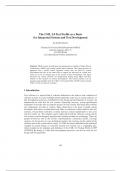The UML 2.0 Test Profile as a Basis
for Integrated System and Test Development
Ina Schieferdecker
Technical University Berlin/Fraunhofer FOKUS
Kaiserin-Augusta-Allee 31
D-10589 Berlin
ina.schieferdecker@fokus.fraunhofer.de
Abstract: Model centric development and engineering according to Model-Driven
Architectures (MDA) has recently gained much attention. This paper presents an
approach how a model centric approach cannot only be used for system
development but also at the same time to support the provision of system tests
which are to be an integral part of the overall system development. The paper
discusses the various artefacts for model-based testing along MDA and their
relation to the artefacts in system development. The testing artefacts can be
designed and modelled with the UML 2.0 Testing Profile (U2TP) which extends
UML 2.0 with test specific concepts.
1 Introduction
Test software is a special kind of software dedicated to the analysis and evaluation of
software systems. It can be modelled and developed the same way as system software, so
that development processes established for the design and development of systems can
theoretically be used also for test systems. Practically however, system specification
techniques do not take into account the specifics of test systems, like being able to define
test components, test data or verdicts. Many efforts have to be spent to enable system
developers and testers to understand each other, to transform system artefacts into test
artefacts, to keep them consistent, to relate and trace system requirements to test cases
and test results, etc. The situation can be improved if both the software system and its
test system(s) can be designed, specified and visualized within one technology. Then, the
people involved as well as the reviews, transformations, consistency checks, coverage
analysis, etc. do not have to cross technology borders, but can focus on the content of the
artefacts such as the system and test logic. As UML has been established as the industrial
standard in system design, its extension towards test systems was a compelling idea,
which resulted in the initiation and definition of the UML 2.0 Testing Profile (U2TP
[U2TP04]) By doing so, UML based development processes can also be used for test
design and test generation.
395
, Model centric development of software system has recently become an important
software engineering strategy for handling the complexity and the increasing
requirements to larger and highly distributed software systems. The OMG initiative on
Model Driven Architectures (MDA) prescribes certain model artefacts to be used along
system development, how those models may be designed and their relationship
[MDA03]. It is an approach to system development that separates the specification of
functionality from the specification of the implementation of that functionality on a
specific technology platform [QVT04]. Main MDA artefacts are computationally
independent platform models (CIMs), platform independent system models (PIMs),
platform specific system models (PSMs) and system code [KWB03]. There is a clear
distinction between CIM, PIM, PSM and system code although it depends on the
context, the development process and the details of the system and target platform,
where the borders between CIM, PIM, PSM and system code are to be placed. Within
these abstraction levels, transformation techniques are used to translate model parts of
one abstraction level into model parts on another abstraction level. These
transformations can also be used to specify the relations and invariants between the
models on different abstraction levels, which are the base to check the consistency
between models and to validate models against each other. These MDA abstraction
levels can also be applied to test modelling [G03] as according to the philosophy of
MDA, the same modelling mechanism can be re-used for multiple targets [S01].
Similarly, test models can be specified independent from the computations, independent
from the platform details and specifically for a target platform before generating
executable test codes [D04].
2 The UML 2.0 Testing Profiles
The UML 2.0 Testing Profile (U2TP) defines a language for designing, visualizing,
specifying, analyzing, constructing and documenting the artefacts of test systems. It is a
test modelling language that can be used with all major object and component
technologies and be applied to test systems in various application domains. Being a
profile, the U2TP seamlessly integrates into UML. It is based on the UML 2.0 meta-
model [2] and reuses UML 2.0 syntax.
The UML 2.0 Testing Profile provides concepts that target both the pragmatic and
systematic development of concise test specifications and test models for black-box and
grey-box testing [U2TP04,U2TP04a]. In particular, the profile introduces concepts
covering: test architecture, test behaviour, test data, and time. The profile defines testing
concepts, including test context, test case, test component, and verdicts that are
commonly used during testing. Behavioural elements from UML 2.0 can be used to
specify the dynamic nature of test cases. These include interactions, state diagrams, and
activity diagrams. Additional concepts for behaviour include several types of actions
(validation actions, log actions, final actions, etc.), defaults for managing unexpected
behaviours, and arbiters for determining the final verdict for a test case. The definition
and handling of test data is supported by wildcards, data pools, data partitions, data
selectors and coding rules. Timers and time zones are also provided to enable
specifications of test cases with appropriate timing capabilities.
396




